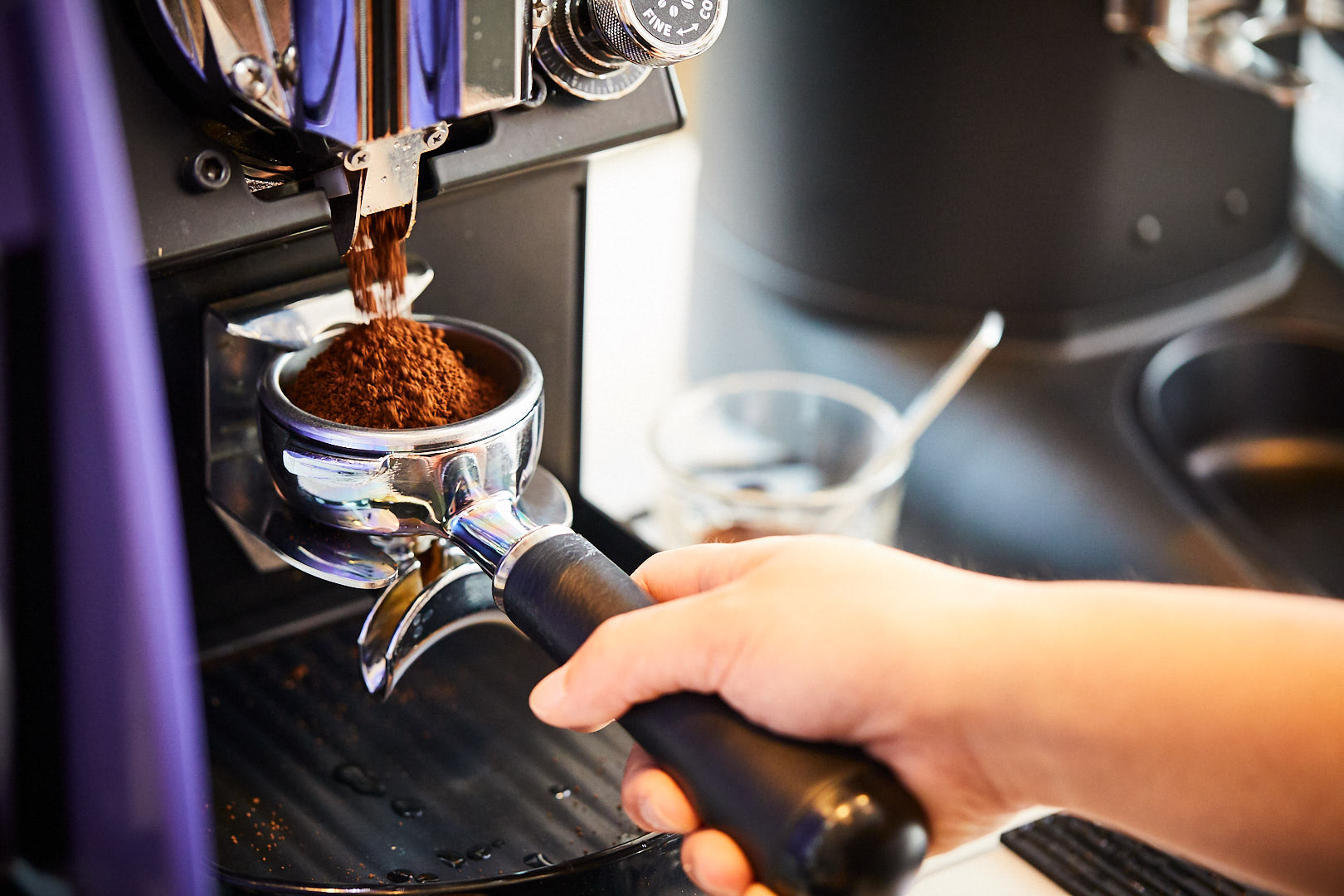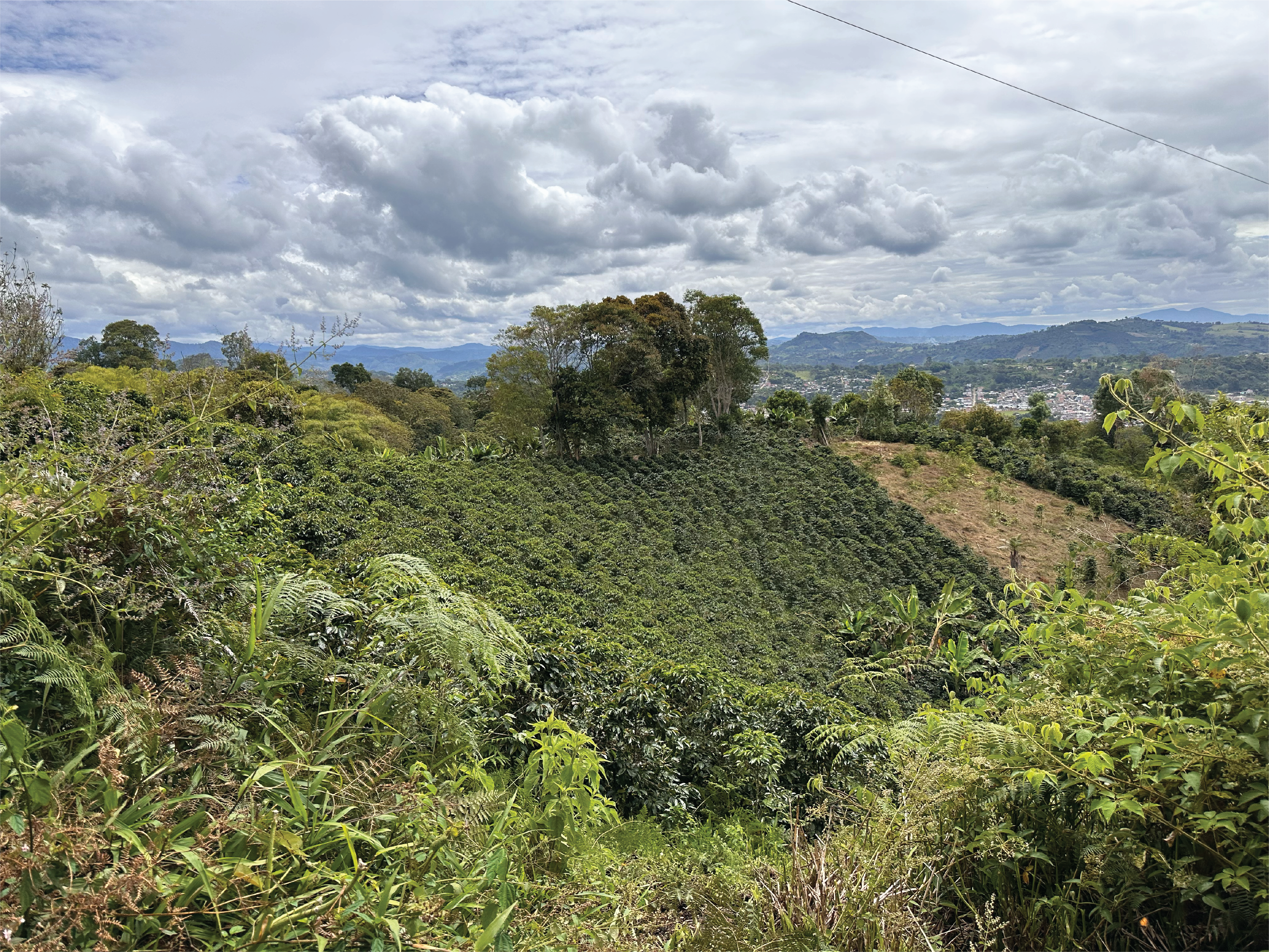In July 2023, we traveled to Colombia to meet with farmers, learn more about producing specialty coffee and experience all that Colombian culture has to offer.
Colombian Coffee Culture
Coffee is handwoven into Colombian culture. Everyone we met on our origin trip, from farmers to office managers to baristas, seemed to have a similar story - since the first few sips as a toddler, coffee has always been there. And it's easy to see why, driving along the cordilleras, the lush green hillside dressed with clean-cut rows of coffee crops. The land is abundant, generative, and ripe for growing food.

Of the country's 32 departments, 23 produce coffee, each with a unique reputation. Diverse microclimates make for drastically different cup profiles from one municipality to the next, meaning there's never just one flavor category to describe the taste of Colombian coffee. Some taste like milk chocolate, others are more like watermelon juice. Some are light and tea-like, while others are rich and bold. The final flavor depends on the land's terroir, the plant's variety, and the cherry's processing - that's long before the coffee is roasted or brewed.
Coffee first entered Colombia in 1730 via Jesuit priests from Venezuela, with the first exports leaving the country in 1835. Then in 1927, a few Colombian farmers joined to create the National Coffee Federation (FNC), an organization with a mission to support and uplift coffee producers. Over the last century, the quality of Colombian coffee has continually improved, thanks to the FNC. Nowadays, the country is the third-largest exporter of Arabica beans, recognized for its quality-driven and innovative producers. In Bogotá and Medellín, you can also find a thriving specialty cafe culture.
Pitalito Purchasing Station
We landed in the capital city of Bogotá at 10 p.m. on Sunday, a whopping 2,640 meters (8,660 ft) above sea level. After a brief night's rest, we boarded a 26-passenger prop plane for Pitalito, a famous agricultural hub and the largest, southernmost city in the department of Huila. We joked with our guide, Ignacio, who could quickly point out the fellow coffee buyers onboard (branded trucker caps, laptops, sneakers).

Our first stop was the Caravela purchasing station, where regional farmers bring their lots to sell for profit. Upon arrival, the team will weigh a producer's coffee, pull a small sample, and do a series of tests to assess quality and determine the selling price.
In a matter of hours, analysts measure physical attributes like moisture content and screen size, then roast the sample and cup it to evaluate its flavor, body, and overall cup score. That score will then correlate to a category - RTB (ready to blend) being the lowest, and micro-lots and AAA being the highest - determining the price the farmer receives for their coffee that day. Prices fluctuate and depend on the stock market, so farmers must keep close tabs on the local and global economies to get the best buck for their green.

Ignacio and the Caravela team set up a blind cupping for us of 14 different lots from Huila. Many tasted like brown sugar and orange, the familiar flavors of our Bright Minds, later revealed as A-AA blends of Colombia and Castillo varieties. But a few stood out on the table as significantly brighter and more floral, sweet as pink lemonade, and clean as fresh linen. These were the Pink Bourbons, a highly coveted variety known for its high-scoring sweetness. Our interest was piqued.

Visiting the Farm: Maria Deicy
On the second day, we drove west from Pitalito to San Agustín to see another smaller purchasing station before heading out to two farms. Fidernando, the quality analyst for San Agustín, greeted us with a Pink Bourbon brewed on a V60 (without a scale!!!) that tasted just like raspberry lemonade.
Soon we were also joined by Monica, the area PECA technician. PECA is a free educational program for coffee growers that work with Caravela. With Fider and Monica on a motorcycle and Khanh, Dawson, Ignacio, and myself riding close behind in a white pickup, we snaked up narrow roads to reach Maria Deicy's family farm.

Maria Deicy is one of the producers contributing to Los Naranjos, the cooperative responsible for Bright Minds. Her family is relatively new to specialty coffee; her father grew commercial coffee before he passed, and she inherited his farm. In the last two years, she bought more land and planted higher-quality varieties like Pacamara and Bourbon (with help from PECA).
Maria Deicy confidently led our group through dense fields of coffee trees, proudly pointing out the difference between the neighbor's neglected plants and her neatly manicured Catimors. Along the hike, we frequently stopped to taste the other fruits of her labor - tiny wild blackberries, juicy mandarins, and giant underground networks of fresh yucca.

Back at the house, Maria Deicy and her family put the finishing touches on a traditional Colombian lunch while we toured the on-site wet mill.
Here, coffee cherries are deposited, de-pulped, fermented in a tank with water, and dried in covered patios or casa heldas (rooftop patios with retractable roofs). Most Colombian producers have the equipment to process their coffee on-site at the farm, which is uncommon in other countries like Ethiopia and Brazil. Although fermentation's exact timing and methodology may vary from producer to producer, the wet process is ubiquitous in Colombia.
For lunch, Maria Deicy spoiled us with fresh passionfruit juice, plantain soup, rice, giant avocados, steamed yucca, fresh chicken (which Deicy's daughter was de-feathering when we arrived), thin cuts of tender beef, and sweet fruit salad. Stuffed and sleepy, we exchanged hugs and once-in-a-lifetime thank-yous before trudging down the steep dirt path back to the truck.

Visiting the Farm: Yamile
We barreled across town to the second farmer we were to visit, a young woman named Yamile, who grew one of the delicious Pink Bourbons we'd tasted in Pitalito.
The terrain here was more rugged, and the air was noticeably cooler. The sky looked like rain when the pickup got stuck on a steep curve, Khanh and Dawson gripping the handles above the car door, me in the middle, trying not to lose it completely. Luckily, it wasn't the driver's first time getting stuck in the mud. He jostled the gear shift and pulled us right out, carefully kissing the cliff's edge as we rolled toward a clearing.
Fidernando and Monica waited for us under a giant tree, chatting with Yamile and her mother. Yamile was noticeably younger and more reserved than Maria Deicy. She spoke soft Spanish to Ignacio, who translated.
"There's not much to see," she warned us. The harvest was over. She had sold the last of her ripe cherries to a commercial market, which was more profitable than going through the lengthy drying process. What we tasted yesterday, one of our highest scoring cups on the cupping table, was all we'd get to taste this year.
Yamile led us to a taut drying bed made of mesh and wooden slats, with some speckled pinto beans drying in the corner - "a new coffee variety," Ignacio teased lightly, and we all laughed.
Her wet mill was humble, a wooden funnel leading to a de-pulper and a clay-tiled tub, clean and empty, a pile of ruby-red cascara (the skin of the coffee fruit) on the other side, waiting to be tilled back into the land as compost.
"Artisan coffee," she joked, picking a few dried skins from the crevices in the wooden funnel and tossing them to the ground.
"But your coffee is really, really good," Ignacio reassured her.
As the rain fell, we sat under a covered patio and shared achiras while Yamile told us her story. Years ago, Yamile's father planted hectares of low-quality, high-yield Catimor trees, the harvests of which he sold commercially for minimum market prices. There was no emphasis on quality, budgets, or planning for the future. These days he doesn't come around much, she said. He still owns the land where she, her mother, and her 11-year-old daughter live.

When her daughter was born, Yamile lived and worked in Bogotá for a short time. But the land of her youth called to her, and she eventually returned to San Agustín to help her mother with the farm. She took a coffee-growing workshop hosted by the Colombian government, planted 1000 Pink Bourbon trees on a parcel of land her father gifted her and started selling her high-quality specialty coffee to Caravela for higher prices than her father could ever secure. She showed us the proof in a spiral notebook, handwritten spreadsheets of yield, cost analyses, and careful projections. Thus, a new generation of the farm was born.
For us to work together, Yamile needs to produce more coffee. We intend to keep in touch and look forward to tasting a sample of next year's harvest. She is an inspiring example of what the future of coffee could look like - a network of passionate, innovative people that value quality, transparency, and longevity, supported by customers like you who understand and appreciate the value of a cup of coffee.
The Dry Mill
Later in the week, we flew to Armenia, Quindío, to visit the Caravela dry mill. Once Caravela purchases a coffee at the purchasing station, it travels here by truck for storage, further quality control, and milling. Milling is the process of removing the parchment layer from the green coffee. It's an often overlooked step in the seed-to-cup process, but it can make or break a specialty coffee.

Adorned with hard hats, safety vests, and earplugs, we got up close and personal with the heavy machinery. Trucks arrive here from all over the country. The team weighs the cargo, verifies the driver, then unloads the coffee into the warehouse, where it is carefully sorted and stored.
When a roaster (like Greater Goods) orders green coffee, the parchment enters the factory line. Machines sort out any foreign objects like stones or shells, then sort the coffee by density, size, and even color. Before the final approval, the QC team roasts and cups a small sample to ensure consistent quality. Finally, the coffee goes into a plastic bag, a branded jute coffee sack, onto a truck, and to the port for export.
The Major Takeaways
After the tour, we chatted with Jaime Llano, the country manager for Colombia and Ecuador. Last year was challenging for coffee farmers in South America, he said. Low prices and unpredictable weather caused unexpected hiccups in the supply chain, and many farmers struggled to make ends meet.
"Coffee is a long-term project," Jaime said. Yes, last year was tough. But it's the reality of producing coffee; you must be ready for the unexpected, have a buffer, and think of the farm as a business. Coffee is risky and requires a lot of planning. There is no instant gratification, not like a busy cafe. Coffee trees can take up to five years to produce harvestable fruit. Harvest happens once - maybe twice - per year. Farmers have one chance to make a profit, and the only way to secure that profit year after year is to create sustainable, long-term relationships with the people who buy their coffee, like us.
When it comes time to purchase a new coffee, we gather around the cupping table with all this in mind. For us, the value of a coffee does not rest solely on its flavor. Of course, it should be delicious. But it should also be traceable, sustainable, and something we feel confident investing in for future generations. That's how we make coffee better.






